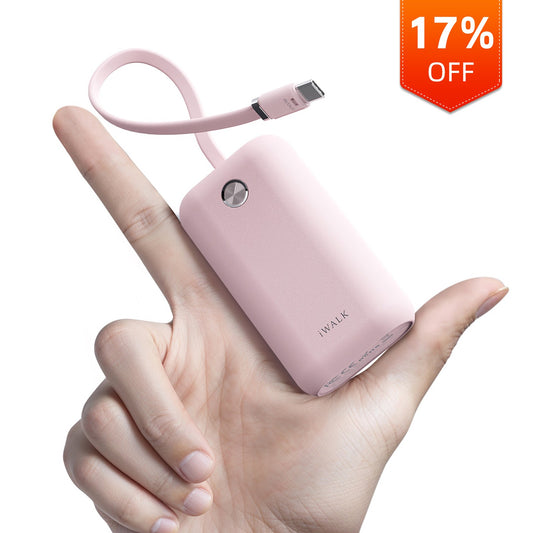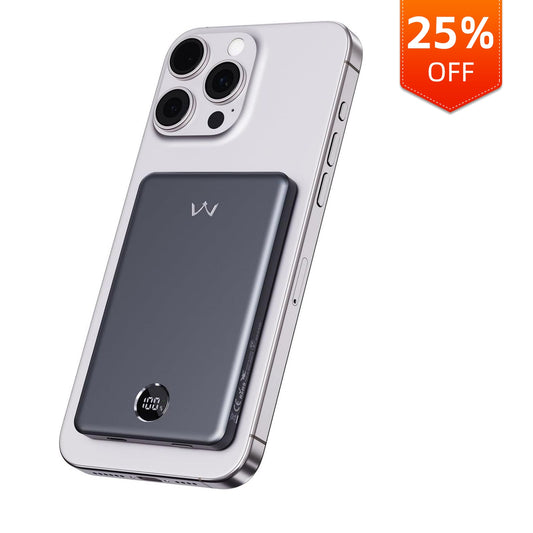Your iPhone 17 represents a significant investment in technology and convenience. Yet many users unknowingly compromise their device's longevity through charging practices that degrade battery health over time. The right charging approach, combined with intelligent hardware, can dramatically extend your phone's usable life while maintaining peak performance.
Is Your iPhone 17 Battery Secretly "Overheating"?
That anxiety when your battery percentage drops faster than expected? The frustration when your device becomes uncomfortably warm during charging sessions? These aren't just inconveniences—they're warning signs of compromised iPhone 17 battery health.
The reality is that speed alone doesn't define a quality charging experience. While fast charging has become standard, true technological sophistication lies in maintaining battery integrity over hundreds of charging cycles. Proper charger temperature control represents the difference between a device that retains 80% of its original capacity after two years versus one that struggles to make it through a full day.
Consider this: Replacing an iPhone battery typically costs between $69-99, not including potential downtime or inconvenience. Investing in charging solutions that prioritize longevity doesn't just preserve performance—it protects your financial investment while reducing electronic waste.
Common Charging Scenarios and Their Hidden Risks
Daily Commute and Overnight Charging
Many users plug in their devices overnight or during their daily commute, unaware of the cumulative impact on battery longevity. Overnight charging keeps batteries at 100% for extended periods, creating sustained stress that accelerates chemical aging. Similarly, using power-intensive applications while charging generates combined thermal loads that push temperatures beyond optimal ranges.
Travel and Outdoor Usage
Charging in hot cars or direct sunlight represents one of the most damaging scenarios for lithium-ion batteries. Ambient temperatures above 35°C (95°F) combined with charging heat create conditions that can permanently reduce capacity after just a few exposure incidents. For travelers, inconsistent power sources and voltage fluctuations further compound these risks.
High-Power Business Usage
Business professionals who rely on rapid charging between meetings often prioritize speed over sustainability. Without sophisticated thermal management, high-wattage charging generates brief but intense heat spikes that gradually degrade battery components. The combination of frequent partial charges and thermal stress creates a perfect storm for accelerated capacity loss.
Choosing an Intelligent Charger: Beyond Speed to Stability
The market offers countless charging solutions claiming superior speed, but discerning users should prioritize technologies that balance performance with preservation. Understanding key specifications helps identify products genuinely designed to protect your iPhone 17 battery health through advanced charger temperature control.
| Consideration Factor | Consumer-Friendly Explanation | Technical Standards | Battery Health Impact |
|---|---|---|---|
| Intelligent Thermal Management | Continuously monitors and adjusts current to maintain "cool" fast charging, preventing heat damage (core selling point) | NTC thermistors, MCU microcontrollers, PD protocol power management | Critical: Directly determines battery lifespan and safety |
| Output Power (W) | PD 20W/22.5W represents the iPhone fast charging sweet spot; higher power without thermal control can be harmful | USB PD (Power Delivery) 2.0/3.0, PPS (Programmable Power Supply) | High: Overloading or unstable output causes heating |
| Battery Cell/Materials | High-density, high-safety lithium polymer cells with fire-resistant casing | UL/CE/FCC certification, V0-grade flame-retardant materials | Medium-High: Affects the charger's own heat dissipation and safety |
| Weight & Portability | Lightweight design that doesn't add burden during travel or commuting | Energy density (Wh/L), product dimensions | Low: Indirectly affects whether users will carry it regularly |
iWALK's Approach: How "Healthy Charging" Philosophy Outperforms Competitors
While many brands chase ever-higher wattage numbers, iWALK focuses on what truly matters for long-term device health: intelligent thermal management. Our "cool charging" philosophy prioritizes sustainable performance over temporary speed gains, recognizing that the best charging experience is one you don't have to think about.
| Feature Comparison | iWALK (LinkPod Series) | Competitor A (Anker) | Competitor B (Baseus) |
|---|---|---|---|
| Thermal Performance | Smart chip with multiple over-temperature protections; noticeably lower temperatures during charging | Includes thermal control, but some products prioritize maximum power output | Good value but variable thermal performance during sustained high-power output |
| "Direct Plug" Portability | Unique direct-plug design eliminates cables; ultra-portable; preferred by Japanese and Korean users | Mostly traditional "brick" designs or magnetic attachments; less portable | Fewer similar product lines; design language tends toward traditional styles |
| User Experience | Simplifies complex fast-charging protocols into seamless, stable safety that users don't notice. | Emphasizes technical specifications and maximum power; higher user education required | -- |
iWALK LinkPod Series: Recommended Battery-Protecting Solutions
LinkPod 5000S (22.5W Upgraded) – Where Style Meets Thermal Control
With 5000mAh capacity and 22.5W fast charging, the LinkPod 5000S combines distinctive Sparkly Diamond aesthetics with advanced thermal management. The built-in intelligent temperature control chip delivers a premium charging experience that remains remarkably cool even during rapid power delivery. This model has gained particular popularity among Japanese and Korean users who value both design sensibility and compact form factors.
Rating: ⭐⭐⭐⭐⭐ (Flagship portable option, ideal for daily commuting)
LinkPod Switch (5000mAh) – Security for Global Travelers
The innovative interchangeable plug design (USB-C & Lightning) means you never need to carry extra charging cables. The smart chip automatically identifies connected devices, delivering optimal safe current while protecting against voltage instability risks during international travel. For frequent flyers and multi-device users, this represents the ultimate in convenience without compromising safety.
Rating: ⭐⭐⭐⭐ (Top choice for cross-platform/multi-device users)
PowerStand 10000 – The Cool "Stand" for Home and Office
With 10000mAh capacity and Qi2 15W wireless charging certification, the PowerStand 10000 serves as both a power bank and a convenient desktop stand. The built-in support allows comfortable viewing while charging, while the separate heat dissipation design and Qi2 temperature standards effectively prevent overheating during extended wireless charging sessions. For desktop users and power consumers seeking wireless efficiency, this solution delivers both convenience and thermal safety.
Rating: ⭐⭐⭐⭐ (Ideal for desktop/heavy users pursuing wireless efficiency)
Authentic Voices: User Trust and Professional Endorsement
Real-world experiences from global users demonstrate how iWALK's thermal management technology delivers on its promises across different usage scenarios and regional preferences.
United States User (Amazon Review)
"I used to worry about my iPhone 17 getting too hot, but the iWALK LinkPod keeps it remarkably cool even during a fast charge. It's a must-have for long trips. The temperature difference compared to my previous charger is noticeable immediately—my phone stays comfortable to touch while charging, which gives me confidence about long-term battery health."
Japanese User (Social Media)
"デザインが可愛くて、ケーブル要らずなのが最高!熱くならないから、バッテリーの持ちも良くなりそう。従来の充電器のように熱くならず、バッテリー状態を気にせず使えています。" (Translation: "The design is cute and cable-free is the best! Since it doesn't get hot, the battery life seems to be improving. Unlike conventional chargers, it doesn't get hot, so I can use it without worrying about battery condition.")
Frequently Asked Questions: Battery Health & Temperature Control
1. How significantly does high temperature impact iPhone battery health?
Heat represents the primary factor in lithium-ion battery degradation. Consistent charging temperatures above 35°C (95°F) accelerate internal chemical reactions, causing irreversible capacity loss. Research indicates that batteries maintained at 25°C (77°F) retain approximately 80% capacity after 2+ years, while those regularly exposed to 40°C (104°F) may degrade to 65% capacity in the same period. iWALK's intelligent thermal control chips precisely manage charging current to maintain temperatures within safe parameters throughout the charging cycle.
2. How can I identify whether my charger is truly "safe"?
Safe chargers should include multiple protection mechanisms: over-charge protection, over-voltage protection, short-circuit prevention, and, crucially, over-temperature protection. Look for international safety certifications like UL, CE, or FCC marks that indicate independent verification. iWALK products comply with these global standards while incorporating advanced heat dissipation materials and proactive thermal management that intervenes before temperatures reach critical levels.
iPhones support maximum fast charging power between 20W-27W under specific conditions. Choosing a charger like the iWALK LinkPod 5000S at 22.5W represents the optimal balance between efficiency and battery preservation. More important than the wattage number is the charger's thermal performance—how effectively it manages heat generation during power delivery. A 20W charger with superior thermal control will better protect your battery long-term than a 30W charger that operates at higher temperatures.











